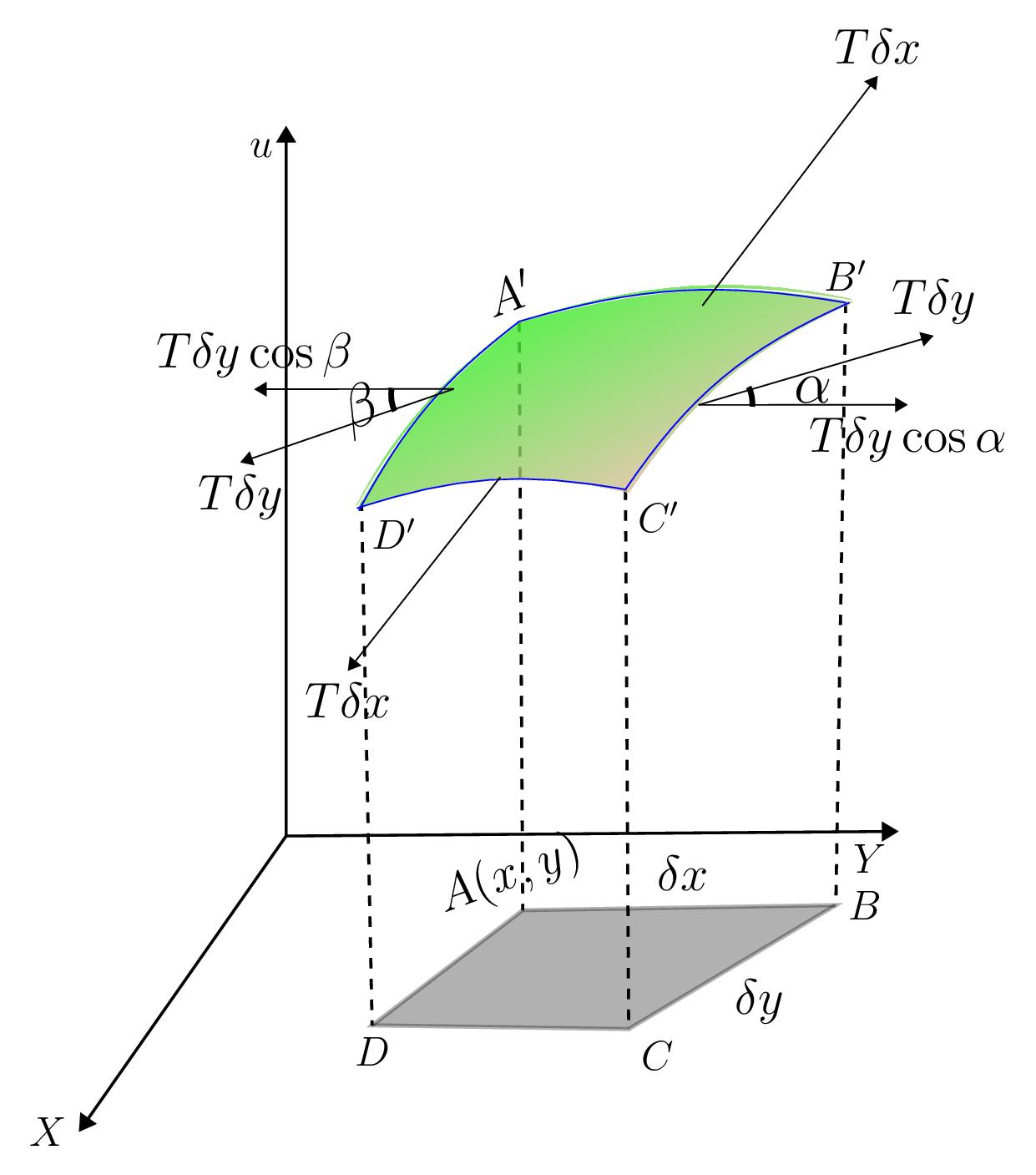Subsection 7.1.3 Two Dimensional Wave Equation for Vibrating Membrane

Let us consider a thin elastic membrane stretched in xy- plane by a uniform tension T per unit length and A’ B’ C’ D’ be the disturbed position of an element of this membrane from its initial position, as shown in figure Figure 7.1.3. Since the deflection \(u(x,y,t)\) of the membrane and angles of inclination of the tensions are small, the sides of the element A’ B’ C’ D’ are approximately equall to \(\delta x\) and \(\delta y\text{,}\) the initial lengths of the element. As the membrane is assumed to be perfactly flexible the tensions acting on the membrane are all tangential. If \(\alpha\) and \(\beta\text{,}\) the inclenations of these tensions with the horizontal are small, the components of these forces at the pair of opposite edges B’ C’ and A’ D’ are \(T\delta y\cos \alpha\) and \(T\delta y\cos \beta\) are approximately equal and opposite in direction as \(\cos \alpha =1 = \cos \beta\text{.}\) Similarly, considering the other pair of edges A’ B’ and C’ D’, we observe that the horizontal components of the forces will be approximately equal and opposite. Thereby we conclude that the motion of the particles of the membrane in horizontal direction is negligibly small, i. e., each particle of the membrane moves vertically. The resultant vertical force on the parallel edges B’ C’ and A’ D’ are
\begin{equation*}
T\delta y \sin \alpha -T\delta y\sin \beta = T\delta y(\tan \alpha -\tan \beta)
\end{equation*}
\(\because \quad \sin \alpha =\alpha = \tan \alpha \) and \(\sin\beta =\beta = \tan\alpha\) as \(\alpha\) and \(\beta\) are small].
\begin{equation*}
=T\delta y\left[\frac{\partial u(x+\delta x,y_{1})}{\partial x}-\frac{\partial u(x,y_{2}}{\partial x}\right]
\end{equation*}
where \(y_{1}\) and \(y_{2}\) are the values of y between \(y\) and \(y+\delta y\text{.}\) Similarly the resultant vertical force acting on the other two edges
\begin{equation*}
=T\delta x\left[\frac{\partial u(x_{1},y+\delta y_{1})}{\partial y}-\frac{\partial u(x_{2},y}{\partial y}\right]
\end{equation*}
where \(x_{1}\) and \(x_{2}\) are the values of x between \(x\) and \(x+\delta x\text{.}\) Hence the total force acting on the elemenrt in the vertical direction is
\begin{equation*}
T\delta y\left[\frac{\partial u(x+\delta x,y_{1})}{\partial x}-\frac{\partial u(x,y_{2})}{\partial x}\right]+T\delta x\left[\frac{\partial u(x_{1},y+\delta y_{1})}{\partial y}-\frac{\partial u(x_{2},y)}{\partial y}\right].
\end{equation*}
If \(m\) be the mass per unit area of the membrane then mass of this element = \(m\delta x\delta y\text{.}\)
As area of the element A’ B’ C’ D’ = \(\delta x\delta y\) and acceleration of the element in a direction perpendicular to \(xy\) plane is \(\frac{\partial^{2} u}{\partial t^{2}}\text{.}\) Hence from Newton’s second law of motion, we have -
\begin{equation*}
m\delta x\delta y\frac{\partial^{2} u}{\partial t^{2}}= T\delta y\left[\frac{\partial u}{\partial x}(x+\delta x,y_{1})-\frac{\partial u}{\partial x}(x,y_{2})\right]
\end{equation*}
\begin{equation*}
+T\delta x\left[\frac{\partial u}{\partial y}(x_{1},y+\delta y_{1})-\frac{\partial u}{\partial y}(x_{2},y)\right]
\end{equation*}
or,
\begin{equation*}
\frac{\partial^{2} u}{\partial t^{2}}=\frac{T}{m}\left[\frac{u_{x}(x+\delta x,y_{1})-u_{x}(x,y_{2})}{\delta x}\right]
\end{equation*}
\begin{equation*}
+\frac{T}{m}\left[\frac{u_{y}(x_{1},y+\delta y)-u_{y}(x_{2},y)}{\delta y}\right]
\end{equation*}
[ \(\because \quad \frac{\partial u}{\partial x}=u_{x};\) and \(\frac{\partial u}{\partial y}=u_{y}\)] Proceeding to the limits as \(\delta x \to 0 \text{,}\) \(\delta y \to 0\text{,}\) we get -
\begin{equation*}
\frac{\partial^{2} u}{\partial t^{2}}=\frac{T}{m}[u_{xx}+u_{yy}]
\end{equation*}
where
\begin{equation*}
u_{xx}= \frac{\partial^{2} u}{\partial x^{2}}=\lim\limits_{\delta x \to 0}\frac{u_{x}(x+\delta x, y_{1})-u_{x}(x,y_{2})}{\delta x}
\end{equation*}
\begin{equation}
\therefore \quad \frac{\partial^{2} u}{\partial t^{2}}=v^{2}(u_{xx}+u_{yy})=v^{2}\nabla^{2}u \tag{7.1.43}
\end{equation}
where \(v^{2}=\frac{T}{m};\) and \(\nabla^{2}= \frac{\partial^{2}}{\partial x^{2}}+\frac{\partial^{2}}{\partial y^{2}}\text{.}\) here \(v\) is the velocity of wave propagating in \(x\) and \(y\) direction. The equation (7.1.43)is called two - dimensional wave equation.
Note. The three - dimensional wave equation is
\begin{equation}
\frac{\partial^{2} u}{\partial t^{2}}=v^{2}(\frac{\partial^{2}}{\partial x^{2}}+\frac{\partial^{2}}{\partial y^{2}}+\frac{\partial^{2}}{\partial z^{2}})u =v^{2}\nabla^{2}u \tag{7.1.44}
\end{equation}
where \(\nabla^{2} = \frac{\partial^{2}}{\partial x^{2}}+\frac{\partial^{2}}{\partial y^{2}}+\frac{\partial^{2}}{\partial z^{2}}\)
